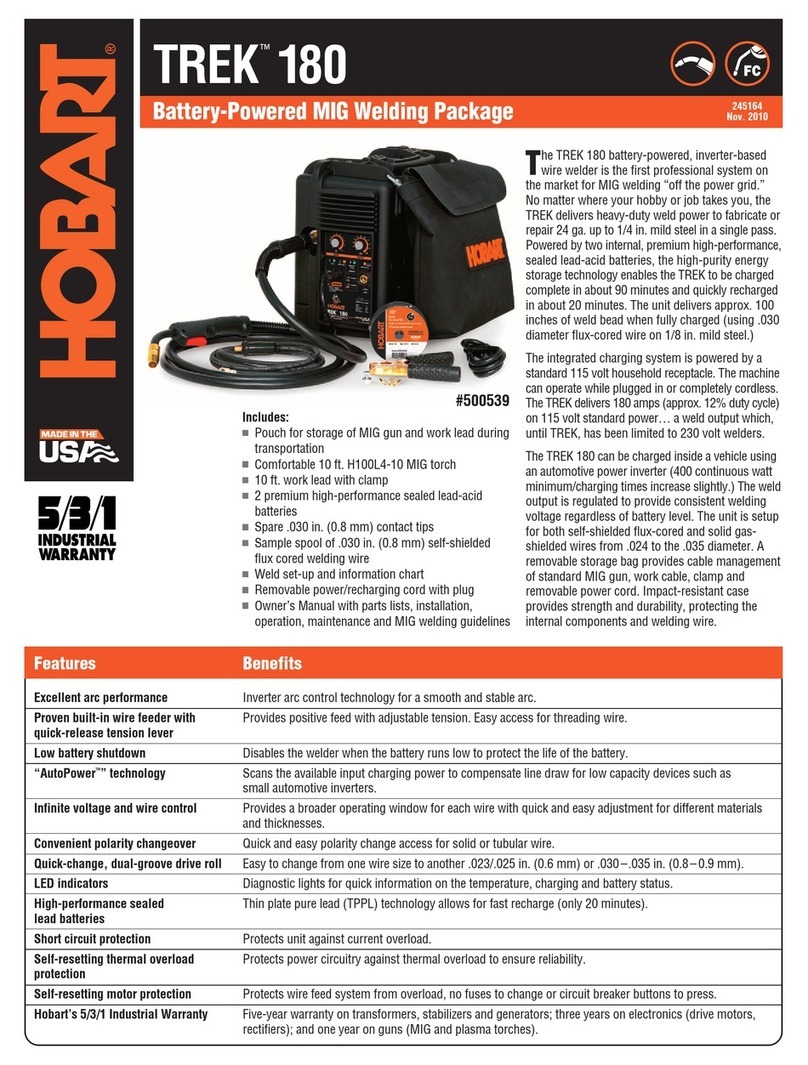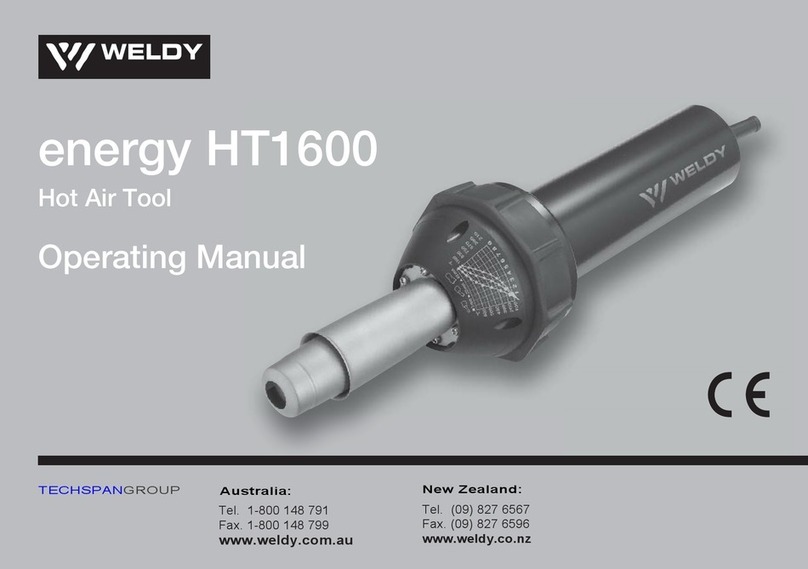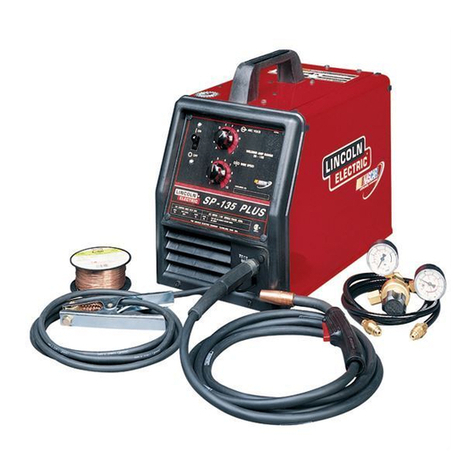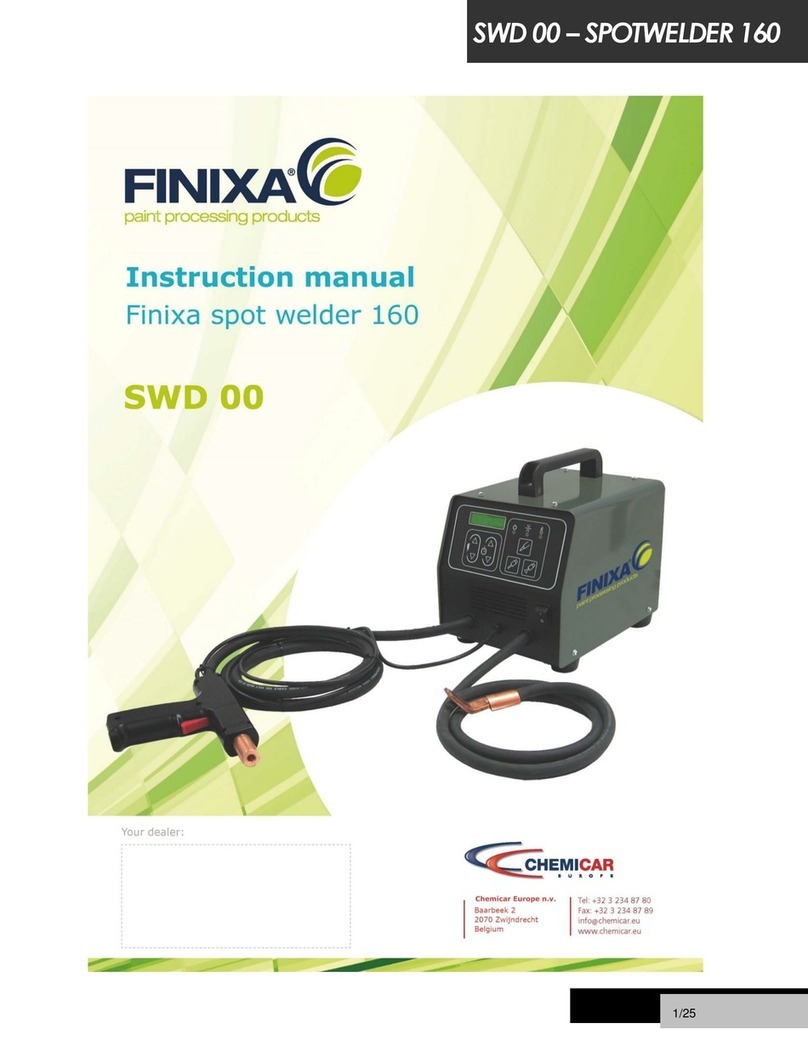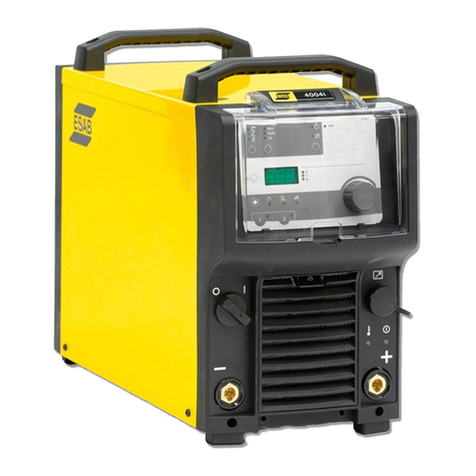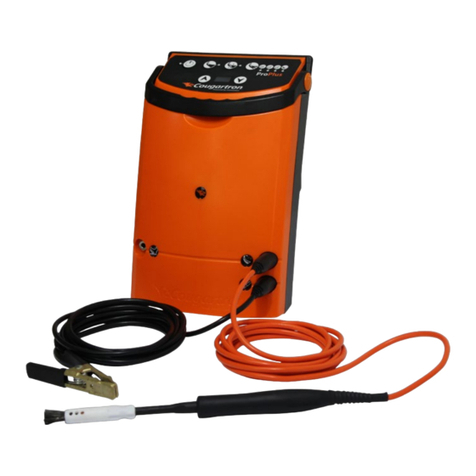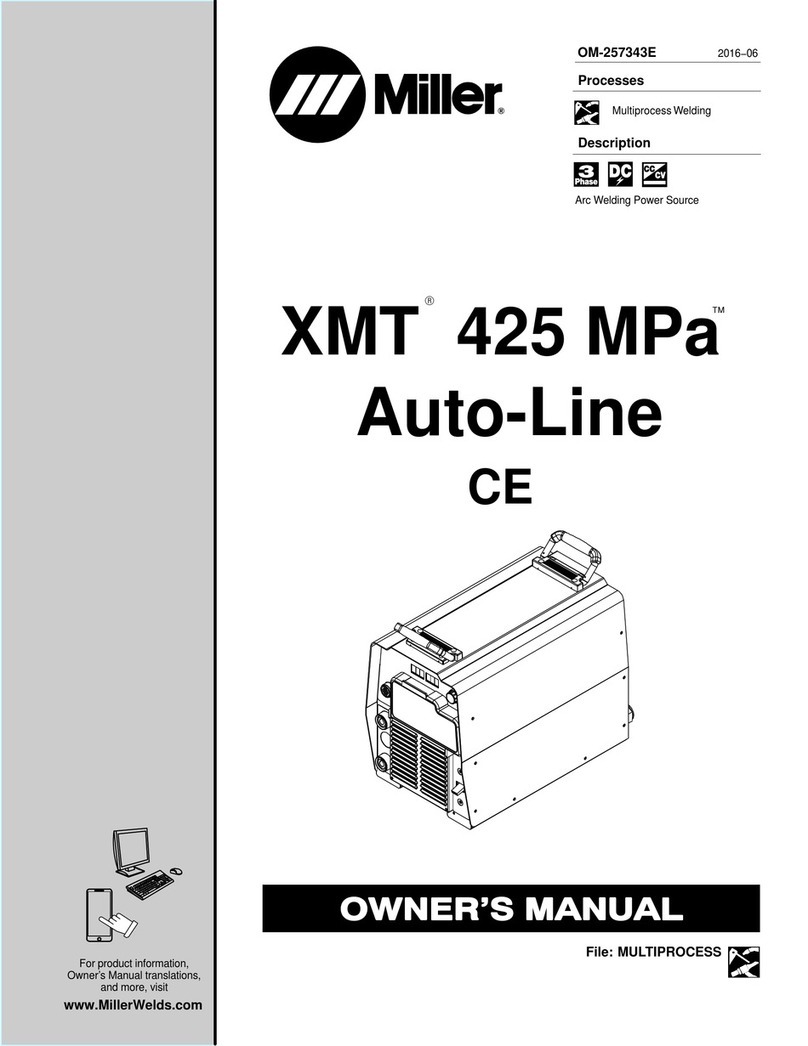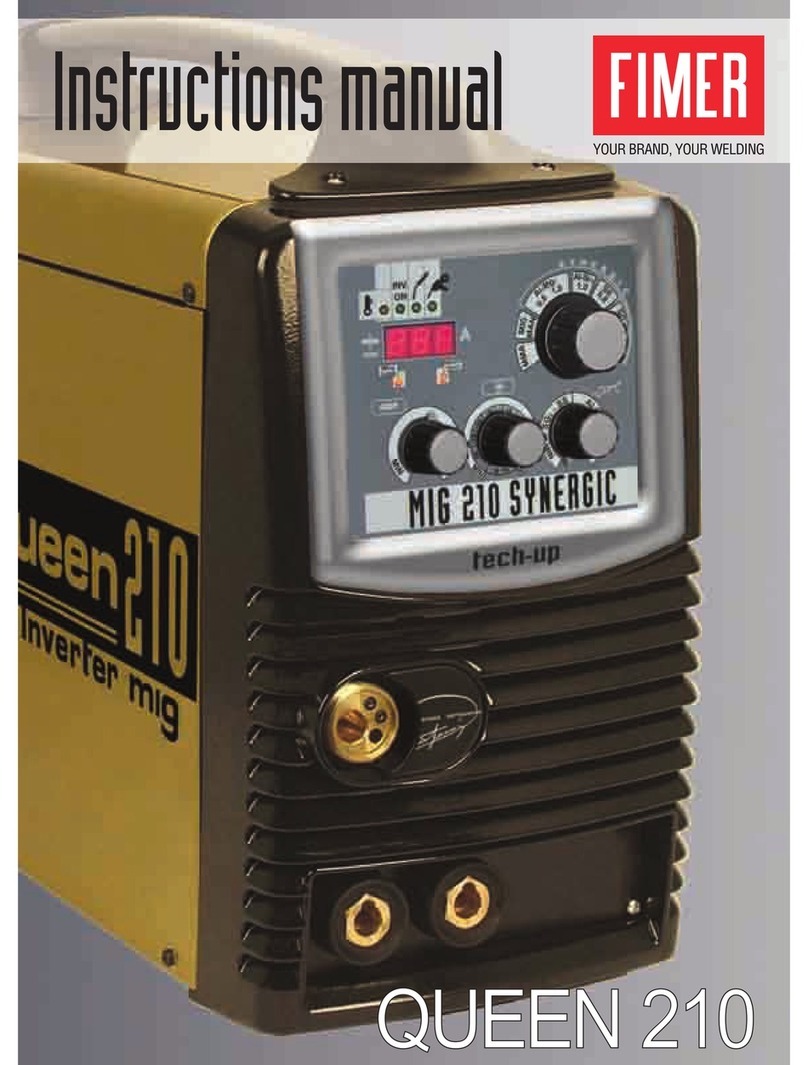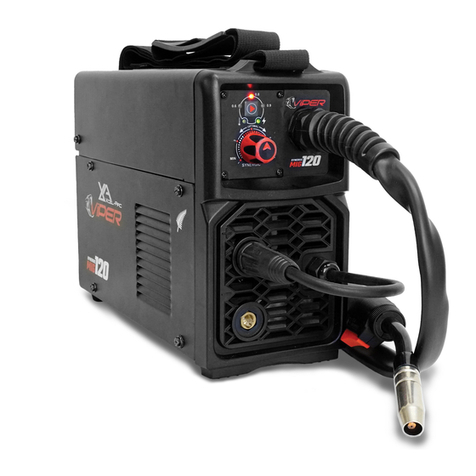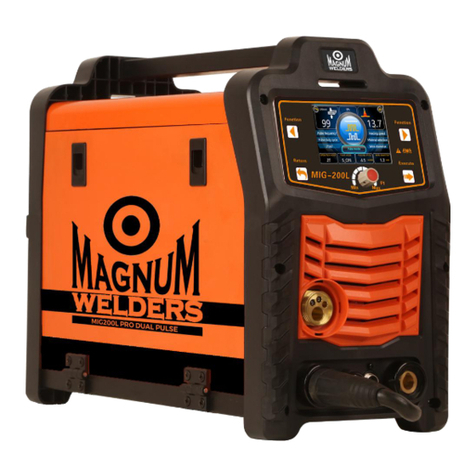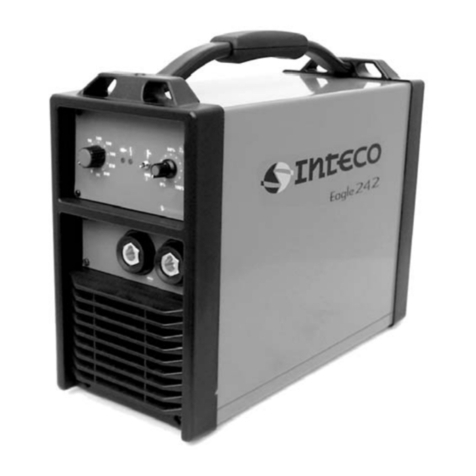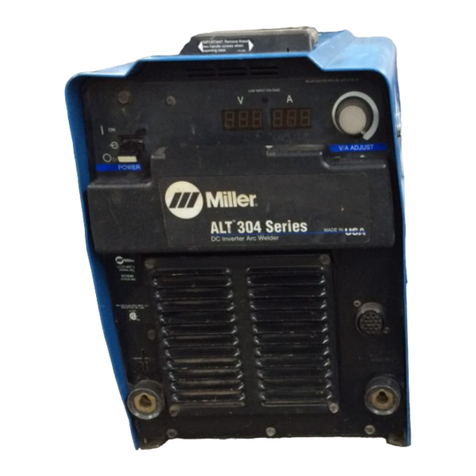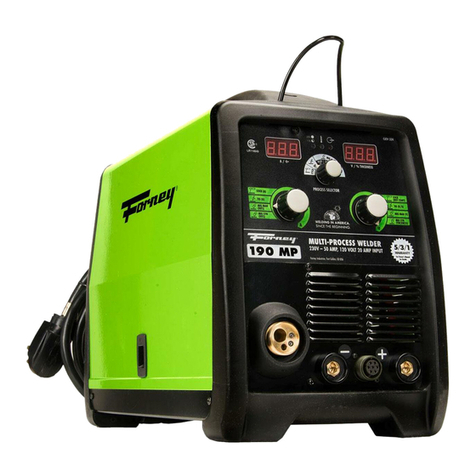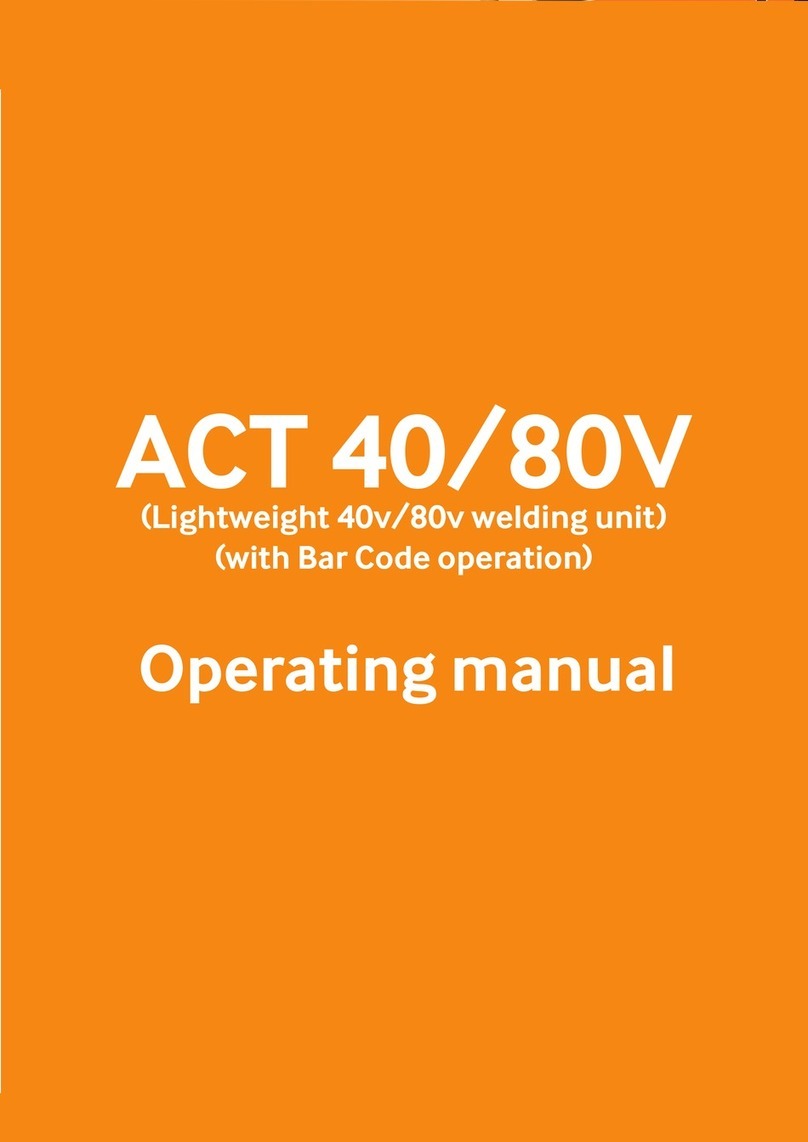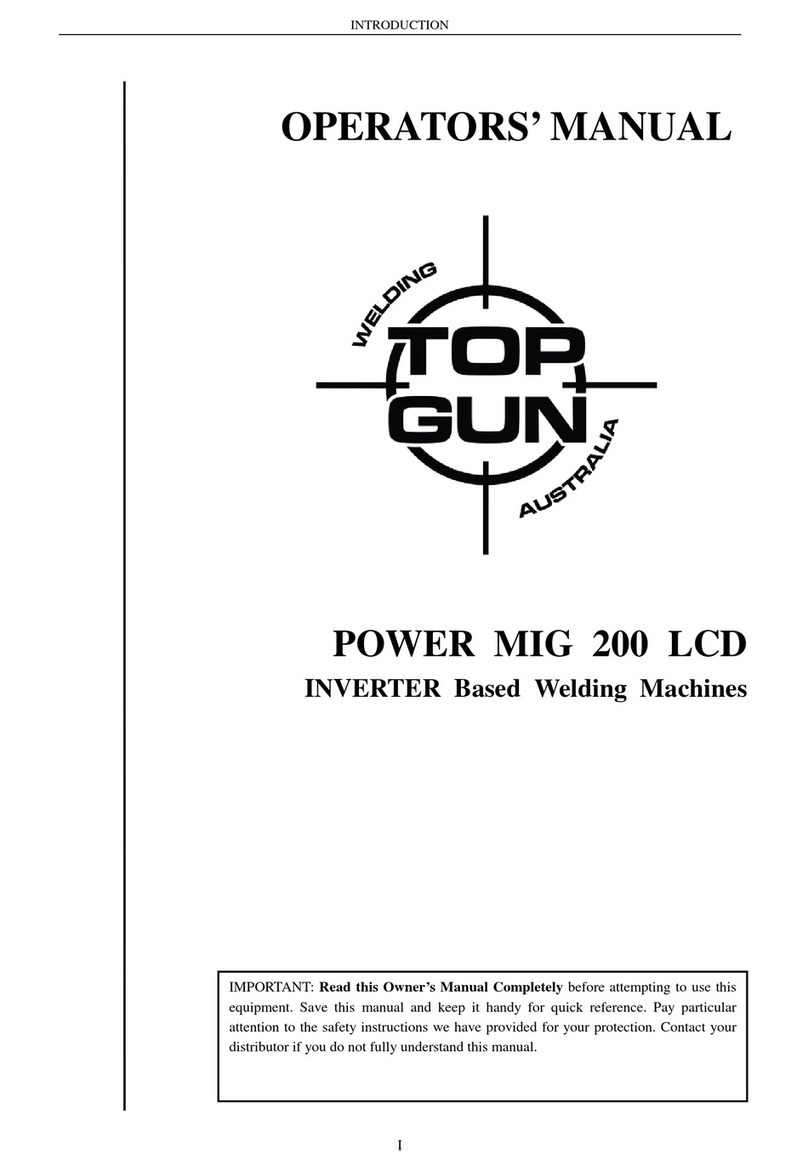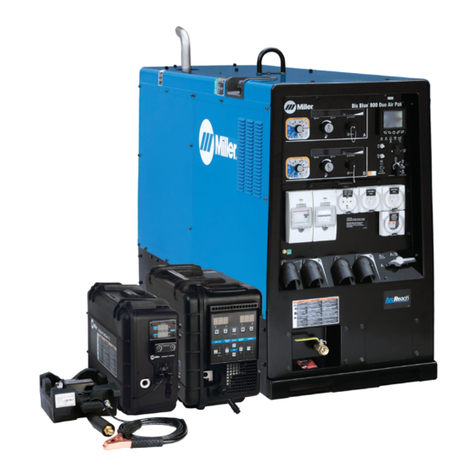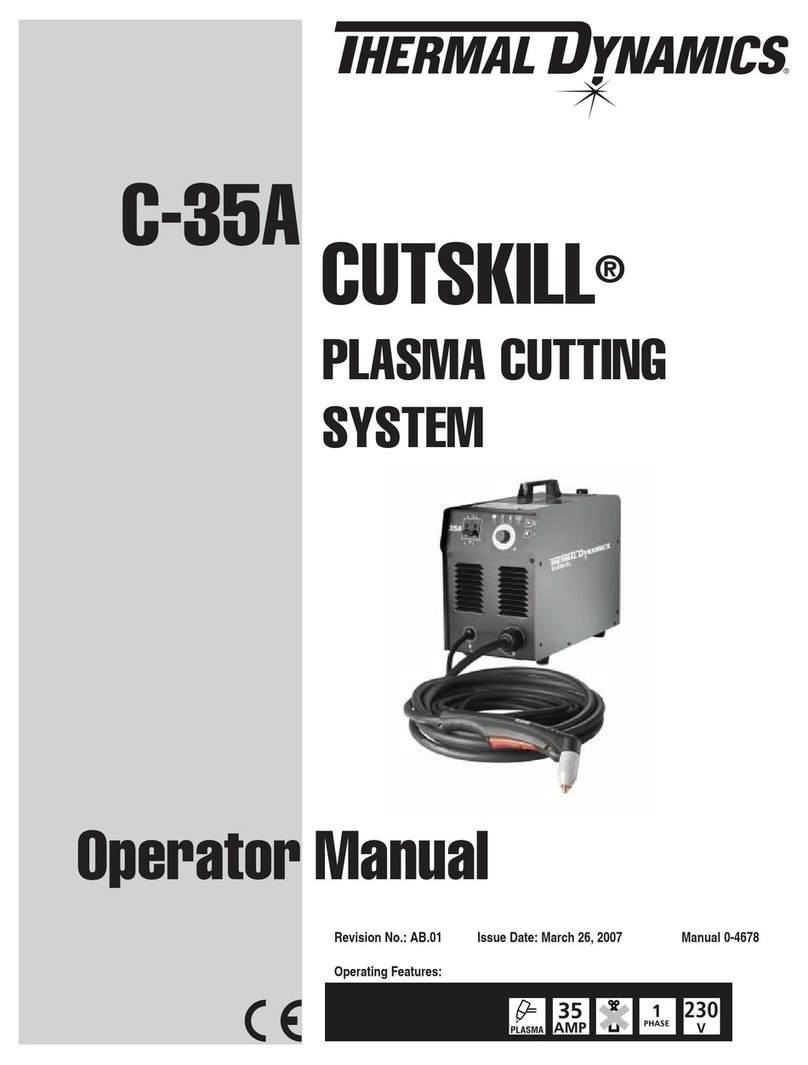OTC DP-400 User manual

MANUAL NO:P10355
OWNER'S MANUAL
FOR
DIGITAL INVERTER
DP400
MODEL: DP-400 P10355
INVERTER CONTROLLED WELDING POWER SOURCE
DO NOT DESTROY
IMPORTANT: Read and understand the entire contents of this
manual, with special emphasis on the safety material throughout
the manual, before installing, operating, or maintaining this
equipment. This equipment and this manual are for use only by
persons trained and experienced in the safety operation of welding
equipment. Do not allow untrained persons to install, operate or
maintain this equipment. Contact your distributor if you do not
fully understand this manual.
DAIHEN Corporation WELDING PRODUCTS DIVISION
June 1, 2004
Upon contact, advise MODEL and MANUAL NO.
CO
2
/MAG/MIG

Notice : Machine export to Europe
This product does not meet the requirements specified in the EC Directives which are the EU safety
ordinance that was enforced starting on January 1, 1995. Please make sure that this product is not
allowed to bring into the EU after January 1, 1995 as it is.
The same restriction is also applied to any country which has signed the EEA accord.
Please ask us before attempting to relocate or resell this product to or in any EU member country or
any other country which has signed the EEA accord.

No. P10355
|1|
TABLE OF CONTENTS
1. SAFETY INFORMATION…………………………………………………………… 2
2. ARC WELDING SAFETY PRECAUTIONS……………………………………… 2
3. GENERAL NOTICE OF OPERATION…………………………………………….. 8
4. STANDARD COMPOSITION AND ACCESSORIES…………………………… 9
5. FUNCTION OF EQUIPMENT……………………………………………………… 11
6. NECESSARY POWER SOURCE EQUIPMENT………………………………… 12
7. TRANSPORT AND INSTALLATION……………………………………………… 13
8. CONNECTION PROCEDURE AND GROUND FOR SAFETY USE………….. 15
9. WELDING PREPARATION………………………………………………………… 18
10. OPERATION…………………………………………………………………………. 29
11. APPLIED FUNCTION……………………………………………………………….. 56
12. MAINTENANCE AND TROUBLESHOOTING…………………………………… 65
13. PARTS LIST…………………………………………………………………………. 72
14. SPECIFICATIONS…………………………………………………………………... 74
15. SERVICE AND SUPPORT………………………………………………………… 78

No. P10355
|2|
1. SAFETY INFORMATION
The following safety alert symbols and signal words are used throughout this manual to
identify various hazards and special instructions.
WARNING WARNING gives information regarding possible personal injury
or loss of life.
CAUTION CAUTION refers to minor personal injury or possible equipment
damage.
2. ARC WELDING SAFETY PRECAUTIONS
WARNING
ARC WELDING can be hazardous.
PROTECT YOURSELF AND OTHERS FROM POSSIBLE SERIOUS INJURY OR DEATH.
Be sure to:
E
Keep children away.
E
Keep pacemaker wearers away until consulting a doctor.
Read and understand the summarized safety information given below and the original
principal information that will be found in the PRINCIPAL SAFETY STANDARDS.
Have only trained and experienced persons perform installation, operation, and
maintenance of this equipment.
Use only well maintained equipment. Repair or replace damaged parts at once.
ARC WELDING is safe when precautions are taken.

No. P10355
|3|
2. ARC WELDING SAFETY PRECAUTIONS (continued)
ELECTRIC SHOCK can kill.
Touching live electrical parts can cause fatal shocks or severe burns. The electrode and work
circuits are electrically live whenever the output is on. The power line and internal circuits of
this equipment are also live when the line disconnect switch is on. When arc welding all metal
components in the torch and work circuits are electrically live.
1. Do not touch live electrical parts.
2. Wear dry insulating gloves and other body protection that are free of holes.
3. Insulate yourself from work and ground using dry insulating mats or covers.
4. Be sure to disconnect the line disconnect switch before installing, changing torch parts
or maintaining this equipment.
5. Properly install and ground this equipment according to its Owner’s Manual and national,
state, and local codes.
6. Keep all panels and covers of this equipment securely in place.
7. Do not use worn, damaged, undersized, or poorly spliced cables.
8. Do not touch electrode and any metal object if POWER switch is ON.
9. Do not wrap cables around your body.
10. Turn off POWER switch when not in use.
A
RC RAYS can burn eyes and skin: FLYING SPARKS AND HOT METAL can
cause injury. NOISE can damage hearing.
Arc rays from the welding process produce intense heat and strong ultraviolet rays that can
burn eyes and skin.
Noise from some arc welding can damage hearing.
1. Wear face shield with a proper shade of filter (See ANSI Z 49.1 listed in PRINCIPAL
SAFETY STANDARDS) to protect your face and eyes when welding or watching a welder
work.
2. Wear approved safety goggles. Side shields recommended.
3. Use protective screens or barriers to protect others from flash and glare: warn others not
to look at the arc.
4. Wear protective clothing made from durable, flame-resistant material (wool and leather)
and foot protection.
5. Use approved earplugs or earmuffs if noise level is high.
Chipping and grinding can cause flying metal. As welds cool, they can throw off slag.
6. Wear approved face shield or safety goggles. Side shields recommended.
7. Wear proper body protection to protect skin.

No. P10355
|4|
2. ARC WELDING SAFETY PRECAUTIONS (continued)
WELDING can cause fire and explosion.
Sparks and spatter fly off from the welding arc. The flying sparks and hot metal, spatter, hot
base metal, and hot equipment can cause fire and explosion. Accidental contact of electrode or
welding wire to metal object can cause sparks, overheating, or fire.
1. Protect yourself and others from flying sparks and hot metals.
2. Do not weld where flying sparks can strike flammable material.
3. Remove all flammables within 10m (33ft) of the welding arc. If this is not possible, tightly,
cover them with approved covers.
4. Be alert that welding sparks and hot metals from welding can easily pass through cracks
and openings into adjacent areas.
5. Watch for fire, and keep a fire extinguisher nearby.
6. Be aware that welding on a ceiling, floor, bulkhead, or partition can ignite a hidden fire.
7. Do not weld on closed containers such as tanks or drums.
8. Connect base metal side cable as close to the welding area as possible to prevent the
welding current from traveling along unknown paths and causing electric shock and fire
hazards.
9. Remove stick electrode from holder or cut off welding wire at contact tip when not in use.
10. Does not use the welding power source for other than arc welding.
11. Wear oil-free protective garments such as leather gloves, a heavy shirt, cuffless trousers,
boots, and a cap.
12. A loose cable connection can cause sparks and excessive heating.
13. Tighten all cable connections.
14. When there is an electrical connection between a work piece and the frame of wire feeder or
the wire reel stand, are may be generated and cause damage by a fire if the wire contacts
the frame or the work piece.
FUMES AND GASES can be hazardous to your health.
Arc welding produce fumes and gases. Breathing these fumes and gases can be hazardous to
your health.
1. Keep your head out of the fumes. Do not breathe the fumes.
2. Ventilate the area and/or use exhaust at the arc to remove welding fumes and gases.
3. If ventilation is poor, use an approved air-supplied respirator.
4. Read the Material Safety Data Sheets (MSDS) and the manufacturer’s instructions on
metals, consumables, coatings, and cleaners.
5. Do not weld or cut in locations near degreasing, cleaning, or spraying operations.
The heat and rays of the arc can react with vapors to form highly toxic and irritating gases.
6. Work in a confined space only if it is well ventilated, or while wearing an air-supplied
respirator. Shielding gases used for welding can displace air causing injury or death.
Be sure the breathing air is safe.

No. P10355
|5|
2. ARC WELDING SAFETY PRECAUTIONS (continued)
CYLINDER can explode if damaged.
A shielding gas cylinder contains high-pressure gas. If damaged, a cylinder can explode.
Since gas cylinders are normally part of the welding process, be sure to treat them carefully.
1. Use only correct shielding gas cylinders, pressure regulators for gas cylinders, hoses, and
fittings designed for the specific application; maintain them in good condition.
2. Protect compressed gas cylinders from excessive heat, mechanical shock, and arcs.
3. Keep the cylinder upright and securely chained to a stationary support or a rack to prevent
falling or tipping.
4. Keep cylinders away from any welding or other electrical circuit.
5. Never touch cylinder with welding electrode.
6. Read and follow instructions on compressed gas cylinders, associated equipment, and the
CGA publication P-1 listed in PRINCIPAL SAFETY STANDARDS.
7. Turn face away from valve outlet when opening cylinder valve.
8. Keep protective cap in place over valve except when gas cylinder is in use or connected for
use.
9. Do not disassemble or repair the pressure regulators for gas cylinders except for the
person authorized by the manufacturer of them.
Rotating parts may cause injuries. Be sure to observe the following.
If hands, fingers, hair or clothes are put near the fan’s rotating parts or wire feeder’s feed roll,
injuries may occur.
1. Do not use this equipment if the case and the cover are removed.
2. When the case is removed for maintenance/inspection and repair, certified or experienced
operators must perform the work. Erect a fence, etc. around this equipment to keep others
away from it.
3. Do not put hands, fingers, hair or clothes near the rotating fans or wire feed roll.

No. P10355
|6|
2. ARC WELDING SAFETY PRECAUTIONS (continued)
ARC WELDING work areas are potentially hazardous.
FALLING or MOVING machine can cause serious injury.
When hanging the welding power source by a crane, do not use the carrying handle.
Put the welding power source and wire feeder solidly on a flat surface.
Do not pull the welding power source across a floor laid with cables and hoses.
Do not put wire feeder on the welding power source.
Do not put the welding power source and wire feeder where they will pit or fall.
WELDING WIRE can cause puncture wounds.
Do not press gun trigger until instructed to do so.
Do not point gun toward any part of the body, other people, or any metal when threading
welding wire.

No. P10355
|7|
PRINCIPAL SAFETY STANDARDS
Arc welding equipment – Installation and use, Technical Specification
IEC 62081, from International Electro technical Commission
Arc welding equipment Part 1: Welding power sources IEC 60974-1, from International Electro
technical Commission
Safety in Welding and Cutting, ANSI Standard Z49.1, from American Welding Society.
Safety and Health Standards, OSHA 29 CFR 1910, from Superintendent of Documents, U.S.
Government Printing Office.
Recommended Practices for Plasma Arc Cutting, American Welding Society Standard AWS C5.2,
from American Welding Society.
Recommended Safe Practices for the Preparation for Welding and Cutting of Containers That Have
Held Hazardous Substances, American Welding Society Standard AWS F4.1, from American
Welding Society.
National Electrical Code, NFPA Standard 70, from National Fire Protection Association.
Safe Handling of Compressed Gases in Cylinders, CGA Pamphlet P-1, from Compressed Gas
Association.
Code for Safety in Welding and Cutting, CSA Standard W117.2, from Canadian Standards
Association, Standards Sales.
Safe Practices For Occupation And Educational Eye And Face Protection, ANSI Standard Z87.1,
from American National Standards Institute.
Cutting And Welding Processes, NFPA Standard 51B, from National Fire Protection Association.
NOTE: The codes listed above may be improved or eliminated. Always refer to the updated codes.
M040414

No. P10355
|8|
3. GENERAL NOTICE OF OPERATION
3.1 Rated Duty Cycle
CAUTION
Use this welding power source at or under the rated duty cycle. Exceeding the rated duty
cycle limitation may result in damage to the welding machine.
xThe rated duty cycle of the welding power source is the following:
400A 50% (for pulse mode)
400A 60% (for DC mode)
xThe duty cycle of 60% means the way the machine is rested for 4 minutes after 6
minutes of continuous welding at the rated current.
Operation cycle of 60% duty cycle
xFailure to observe duty cycle limitations may cause an excess of the tolerance of the
temperature inside the welding machine. This may contribute to premature welding
machine failure or product damage.
xThe figure shown right indicates the relation
between welding current and duty cycle. Use
the welding machine within its usable range,
following the duty cycle for the welding current.
xThe duty cycle of the welding power source is
also limited by the duty cycles of accessories
combined with such as welding torches. Use
the welding machine within the lowest rated
duty cycle of the accessories.
3.2 Applicable Welding Process and Wire Diameter
Refer to Section 10.1.1, “Setting of Welding Mode” for details of applicable welding method and
wire diameter.
3.3 Limitation of use
Do not use this welding power source for pipe thawing.
6 min. 4 min.
10 min.
ON OFF
100
50
0
100
%
(270A or less)
DUTY CYCLE
WELDING CURRENT (A)
(%)
100 200 300
60
%
82
%
DP-400
Usable range
350
(Rated)
50
%
400
(PULSE MODE)
100
50
0
100
%
(310A or less)
DUTY CYCLE
WELDING CURRENT (A)
(%)
100 200 300
60
%
DP-400
Usable range
(Rated)
400
(DC MODE)

No. P10355
|9|
4. STANDARD COMPOSITION AND ACCESSORIES
4.1 Standard Composition
xThe parts names indicated in the boxes are standard parts. They are not supplied with this
welding machine. Preparation of the standard parts except the welding power source is
required to use the welding power source.
xInput cable and grounding cable
For a switch box, the 2m input and grounding cables are from the back panel of welding power
source.
Input cable AWG9 10mm2with 10mm
terminal x 3
Grounding cable AWG9 10mm2with 10mm
terminal x 1
For air cooling torch
For water cooling torch
Base metal
Analog remote control with 10ft (3m) control cable
i
Optionally available
j
Digital remote control
i
Optionally available
j
Input cable 6ft (2m)
Pressure regulators for gas cylinders
Control cable with wire feeder 6ft (2m)
Shield gas
Gas hose 10ft (3m)
Power cable for wire feeder 6ft (2m)
Wire feeder
Welding torch
Power cable for base metal 6ft (2m)
Welding power source
Water cooler
Other length of cable/hose are available. Refer to section 11.4.2 “Cable/Hose”
Note; Use power cable size as follows
Up to 33ft (10m): AWG 2/0 (60mm) Up to 66ft (20m): AWG 3/0 (80mm)
Power cable connectors are attached in power source and wire feeder.
Grounding cable
Shield gas
Bas
e
Analog remote control with 10ft (3m) control cable
i
Optionally available
j
Digital remote control
i
Optionally available
j
Input cable 6ft (2m)
Pressure regulators for gas cylinders
Control cable with wire feeder 6ft (2m)
Shield gas
Gas hose 10ft (3m)
Power cable for wire feeder 6ft (2m)
Wire feeder
Welding torch
Power cable for base metal 6ft (2m)
Welding power source
Grounding cable
(Wire feeder accessory)
(Wire feeder accessory)

No. P10355
|10|
4. STANDARD COMPOSITION AND ACCESSORIES (continued)
4.2 Accessory
Make sure you have the item below before you start using the welding power source.
NOTE:
xWhen using the dust filter, perform 40% (pulse), 50% (DC) or less duty-cycle operation
(without clogging). Otherwise, the welding machine may be damaged. Refer to Section 3.1,
“Rated Duty Cycle”.
4.3 Preparation of consumables for welding
i PjShield Gas
Use a suitable gas for welding method.
xCarbon dioxide gas (CO2gas)
For welding (purity: 99.9% or more, moisture content: 0.002% or less)
xMAG gas
80% argon (Ar) + 20% carbon dioxide gas (CO2gas)
xMIG gas for stainless steel without pulse
90% helium (He) + 7.5% argon (Ar) + 2.5% oxygen (O2)
xMIG gas for stainless steel with pulse
66% argon (Ar) + 33% helium (He) + 1% carbon dioxide gas (CO2gas)
xMIG gas for Aluminum
Pure argon (Ar)
i Qj
Welding Wire
Description Specification Q’ty Part number Remarks
Power cable connector DIX SKK 70 2 4734-025 For the power cable to welding
power source
Dust filter 109-1000M3 2 4519-031 For the fan on the rear panel of
welding power source

No. P10355
|11|
5. FUNCTION OF EQUIPMENT
5.1 Welding Power Source
coSOO Power sw itch
Main power lamp
Output term inal(- )
Output term inal(+)
Socket for w ire feeder
Socket for
analog remote control
Input cable
Parameter adjusting knob
Cap
Carrying handle
Cap
Rubber feet
Grommets with film
i
For pulling out external connection cables j
|
O
Rubber feet
0.8
}
i
2%O2
j
}
e
OP1
CO
2
n o
0.9
1.0
1.2
1.4
1.6
OP2
WARNING
LOAD
SAVE
ENTER
J O B
MEMORY
S ec
A
WELDING
METHOD
SPOT TIME
GAS
CHECK OFF
ON
REPEAT
SPOT
ON SYNERG.
INITIAL
CURR.
ON
T1 T2
SYNERG.
INDIV.
m /m i n
MAIN
CONDITION
INITIAL
CONDITION
CRATER-FILL
CONDITION
i
mm j
MILD STEEL
MILD STEEL
STAINLESS STEEL
MILD STEEL CORED
STAINLESSCORED
V
INCHING
A
m/m in
V
VOLT. CONTROL
A R C
CONTROL
WIRE DIA
C O NS T A N T
PENETR ATION
DISPLAY
CHANGE
MA G
M I G
JOB N O.
CRATER
|
FI LL

No. P10355
|12|
6. NECESSARY POWER SOURCE EQUIPMENT
6.1 Welding Power Source Equipment (for commercial use)
WARNING
When the welding machine is used in such a humid environment as construction site, on the
steel plate, or on steel structure, install a leakage breaker.
CAUTION
Be sure to install a switch with fuse or a circuit breaker (for motor) to the input sides of each
welding machine.
Capacity of Necessary Power Source Utility
MODEL DIGITAL INVERTER
DP-400
Power supply voltage 208/230/460V, Three phase
The welding power source links the
primary voltage automatically.
Tolerance range of fluctuation of power supply voltage 208/230/460V±10%
Installed capacity 24kVA or more
Capacity of switch/circuit breaker 70 A for 208/230V, 50A for 460V
6.2 Precautions for Use of the Engine Generator
CAUTION
Use the auxiliary power of engine welder whose voltage waveform has been improved. Some
of the engine welders have poor electricity, which may cause product damage. Contact an
engine welder manufacturer for improvement of waveform.
To prevent the engine generator or auxiliary power from being damaged, follow the instructions
below.
xSet the output voltage of the engine generator to the voltage range between 230 and 240V at
no-load welding operation. Setting to extremely high output voltage may result in product damage.
xUse the engine generator with a damper winding of which capacity is more than twice as much as
the rated input of the welding machine. Generally, the recovery time of the engine generator’s
voltage for load change is slower than that of the commercial input power source, and if the engine
generator does not have sufficient capacity, sudden current change such as arc start will occur.
This may result in abnormal decrease in output current or arc loss. Ask an engine generator
manufacturer for a damper winding.
xDo not combine more than two welding machines with an engine generator. The affect of each
welding machine may cause easy loss of arc.

No. P10355
|13|
7. TRANSPORT AND INSTALLATION
7.1 Transport
WARNING
Follow the instructions below to avoid trouble and product damage when carrying the welding
machine.
Do not touch the charging parts inside or outside the welding machine.
Be sure to disconnect the line disconnect switch when carrying the welding
machine.
When hanging the welding power source by a crane, do not use the carrying
handle.
7.2 Installation
WARNING
When installing the welding machine, follow the instructions below to avoid a fire caused by
welding and physical damages by fume gas.
Do not place the welding machine near combustible materials and flammable
gas.
Remove combustible materials to prevent dross coming into contact with
combustible objects. If that not possible, cover them with noncombustible
covers.
To avoid gas poisoning and danger of suffocation, wear a gas mask or
adequately ventilate when the welding machine is used in the place regulated
by a local law.
To prevent disorder or poisoning caused by fume, wear a gas mask or weld at
a partial exhaust facility approved by the local regulation.
Adequately ventilate or wear a gas mask when using the welding machine in a
tank, a boiler, a hold of a ship, because heavier gas such as carbon dioxide or
argon gases are drifting there.
When using the welding machine at a narrow space, comply with a trained
supervisor’s directions. And be sure to wear a gas mask.
Do not operate the welding machine near the place where degreasing,
cleansing, and spraying are performed. Otherwise, poisonous gas may be
generated.
Be sure to wear a gas mask or adequately ventilate when welding a coating
steel plate. (Poisonous gas and fume may be generated.)

No. P10355
|14|
7. TRANSPORT AND INSTALLATION (continued)
CAUTION
To prevent electromagnetic troubles, read the following.
A
lso, if electromagnetic
troubles occur, check the following again.
Since large current abruptly flows inside the welding machine during welding, other machines
near the welding power source may be troubled due to electromagnetic noise
Do not ground the welding power source commonly with other machines.
Close and fix all doors and covers of the welding machine.
Do not use an unnecessarily long cable.
Place a base metal cable and a torch side cable as closely as possible.
In the event of electromagnetic trouble, follow the instructions below.
Change the installation place of the welding machine.
Keep the machines which may be affected away as far from the welding machine, cables and
welding site as possible.
Add a noise filter to the input cables.
Mount an input cable in the grounded metallic conduit.
Shield the whole welding places from electromagnetic trouble. If electromagnetic troubles are
still not solved after following the above instructions, consult your nearest DAIHEN dealer.
CAUTION
Follow the instructions below when selecting an installation place of the welding power source.
Do not install the welding power source in the place subject to direct sunlight and rain.
Place the welding machine on a strong and stable surface.
Install the welding machine in the place where the ambient temperature is between -10 ˚C and
+40 ˚C (+14 ˚F and +104 ˚F).
Do not install the welding machine in the place where metal material such as spatter enters the
welding power source.
Keep the install distance of 1ft (30 cm) between the welding power source and the wall or other
welding power.
Install a wind shield to protect arc from wind.
Fix the gas cylinder to the stand only for gas cylinder.

No. P10355
|15|
Base metal
Analog remote control
i
Optionally available
j
Welding power source
Welding torch
Power cable for base metal
Wire
feeder
Gas flow regulator
Control cable for wire feeder
Shield gas
Gas hose
Power cable for wire feeder
Control cable for remote control
M10 terminal
@
A
C
D
B
Base metal
Analog remote control
i
Optionally available)
Welding power source
Welding torch
E
Power cable for base metal
@
Control cable for wire feeder
C
G
as
cylinder
Power cable for wire feeder
A
Control cable for remote control
Wire feeder
Gas hose
D
Water cooler
Water hose
M10 terminal
F
For feeding water
(
for condensed water)
Gas flow rate regulator
8. CONNECTION PROCEDURE AND GROUND FOR SAFETY USE
WARNING
Follow the instructions below to avoid electric shock.
Do not touch the charging parts, as this will result in fatal shock and severe burn.
Do not touch the charging parts of the welding machine.
Have a qualified electric engineer ground the case of the welding power source and the base
metal or jig electrically connected, following a local low.
With the line disconnect switch inside the switch box all turned off, ground and connect the
welding machine.
Do not use a cable with lack of capacity or a cable seriously damaged.
Tighten and insulate the connections of cables.
Surely attach the cover of the welding machine after connection of the cables.
8.1 Connecting of the Welding Power Source
When using the air-cooled torch
When using the water-cooled torch
NOTE: In case of putting the “Abnormal water pressure” signal into the welding power source, see
11.2.
Surely insert the connector plugs
into the sockets for wire feeder
and for analog remote control up
to the sto
p
b
y
turnin
g
them
Gas cylinder

No. P10355
|16|
8. CONNECTION PROCEDURE AND GROUND FOR SAFETY USE (continued)
Follow the steps below to attach the cables to the output connectors of the welding power source
referring to the illustrations of “Connection of the Welding Power Source“ on the previous page.
1. Connect between the “base metal
- “ terminal and the base metal using the power cable for
base metal.
2. Attach the power cable for wire feeder to the “torch
+ “ output terminal and connect to the torch
cable.
3. Insert the control cable for wire feeder into the socket for wire feeder.
4. Attach the gas hose to the gas inlet on the wire feeder.
5. Connect the welding torch to the wire feeder.
6. Connect the hoses for water supply and for condensed water to the water cooler. (When using a
water-cooled torch.)
8.2 Connecting of the Gas Hose
WARNING
Y
ou may suffer from danger of suffocation caused by lack of oxygen when
shield gas keeps drifting in a closed place. Be sure to turn off the shield gas
at the main when the welding power source is not in use.
CAUTION
Be sure to connect the gas hose after fixing to the stand, as physical injuries may result
from falling down of gas cylinder.
Attach a proper gas flow regulator to a gas cylinder. Failure to observe the demand may
result in physical injuries. The gas flow regulator for high pressure gas must be used.
1. Securely attach the gas hose to the gas inlet located on the rear side of the wire feeder with a
monkey wrench, etc.
2. Fix the nut for attaching gas cylinder to the gas cylinder with a monkey wrench, etc.
3. Securely attach the gas hose to the gas outlet with a monkey wrench, etc.
Gas cylinder
Gas flow rate regulator
Gas outlet
@
A
B
Nut for attaching gas cylinder
Wire feeder
Gas hose fitting size: 9/16-18UNF

No. P10355
|17|
8. CONNECTION PROCEDURE AND GROUND FOR SAFETY USE (continued)
WARNING
Follow the instructions below to avoid electric shock.
Touching the charging parts may result in fatal electric shock and severe burn.
Do not touch the charging parts of the welding machine.
Have a qualified electric engineer ground the case of the welding power source and the base
metal or jig electrically connected in accordance with a local low.
With the line disconnect switch in the switch box all touched off, ground and connect the
welding machine.
CAUTION
Be sure to install a switch with fuse or a circuit breaker (for motor) to the input sides of each
welding machine.
CAUTION
Be sure to ground the case of the welding power source.
Use a grounding cable of which thickness is more than AWG9 (10mm2).
If the welding power source which is not grounded is used, voltage will be generated in the
case through the capacitor between the welding power source input circuit and the case or
floating capacity (electrostatic capacity naturally generated between the input conductor and
the case metal). If you touch the case or the base metal, you may suffer from electric shock.
Be sure to ground the case of the welding power source.
Mount a switch with fuse or a circuit breaker
on each welding machine.
GREEN cable
for
Grouding cable
Base metal/JIG
Input cable
Surely connect the input and grounding cables
AWG9 (10mm
2
) to the circuit breaker .

No. P10355
|18|
9. WELDING PREPERATION
9.1 Preparing the Protective Equipment
To protect you from gas generated from welding, fume, and lack of oxygen,
wear protective equipment.
To avoid gas poisoning and danger of suffocation, wear a gas mask or adequately ventilate
when the welding machine is used in the place regulated by a local law.
To prevent disorder or poisoning caused by fume, wear a gas mask or weld at a partial
exhaust facility approved by the local regulation.
Adequately ventilate or wear a gas mask when using the welding machine in a tank, a boiler,
a hold of a ship, because heavier gas such as carbon dioxide or argon gases are drifting
When using the welding machine at a narrow space, comply with a trained supervisor’s
directions. And be sure to wear a gas mask.
Do not operate the welding machine near the places where degreasing, cleansing, and
spraying are performed. Otherwise, poisonous gas may be generated.
Be sure to wear a gas mask or adequately ventilate when welding a coating steel plate.
(Poisonous gas and fume may be generated.)
NOTE: Install a windshield to protect arc from wind when using an electric fan for
ventilation or when welding outdoors. Failure to observe the demand may result in poor
welding.
CAUTION
Use the protective equipment to protect you and other workers from arc rays,
spattering dross, and noise from welding operation.
When performing or monitoring welding operation, wear an eye protector with a good light
blocking effect or face shield.
Wear protective glasses to protect your eyes from the spattering dross.
Wear protective equipment such as protective gloves, long-sleeve clothes, leg covers, and
leather apron.
Install protective screens or barriers to protect the eyes of others in the work area from arc
ray.
Wear an ear protector when noise level is high.
Table of contents
Other OTC Welding System manuals

OTC
OTC MTX-3531 User manual
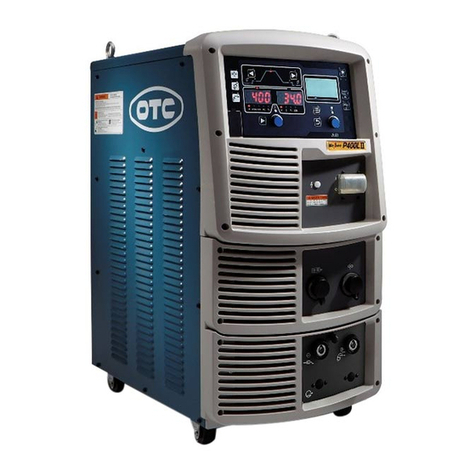
OTC
OTC Welbee P400L II User manual
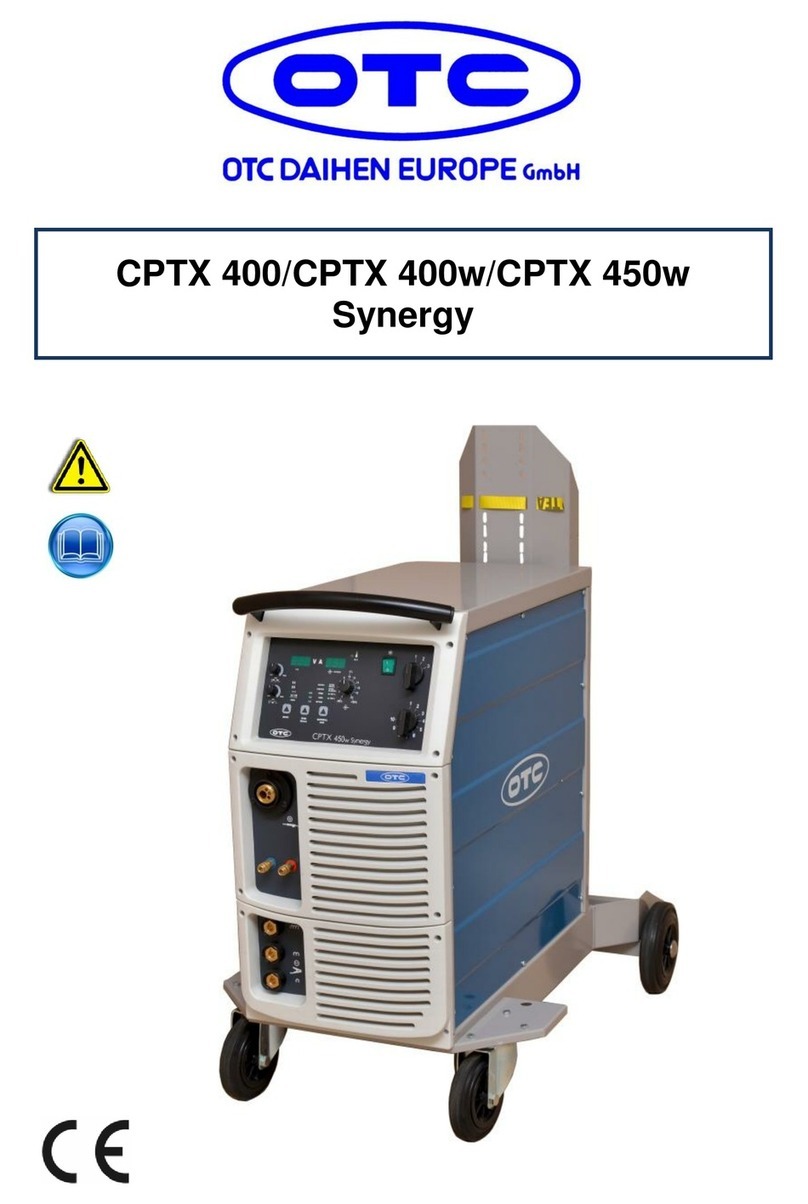
OTC
OTC Synergy CPTX 400 User manual

OTC
OTC CPTX 450-2w Synergy User manual
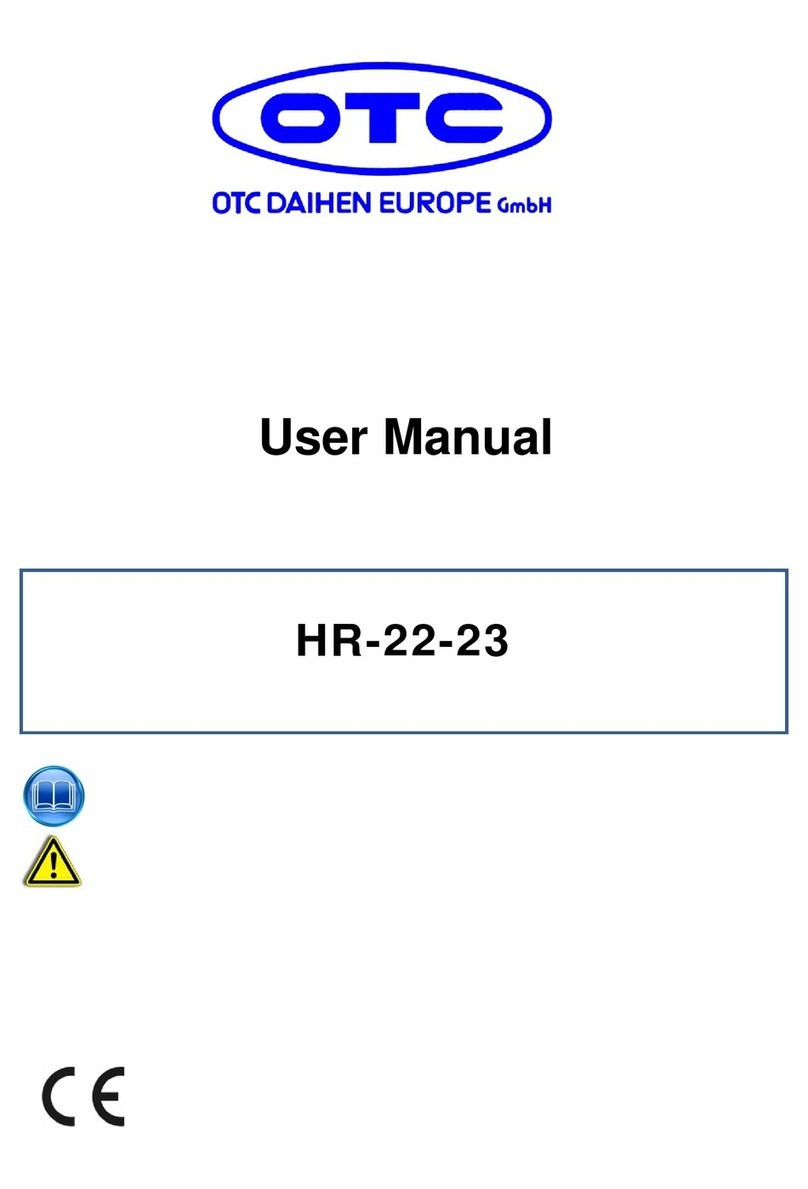
OTC
OTC HR 22 User manual
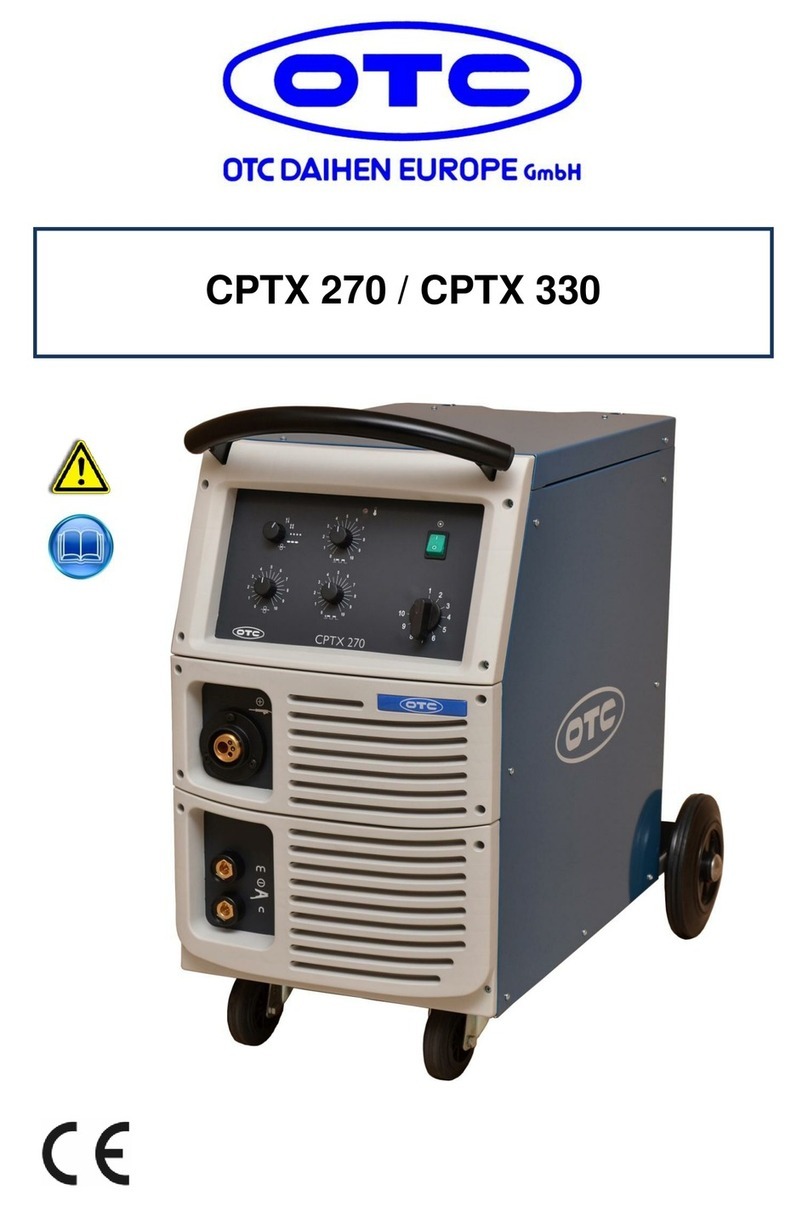
OTC
OTC CPTX 270 User manual

OTC
OTC DTX-2200 AC/DC User manual
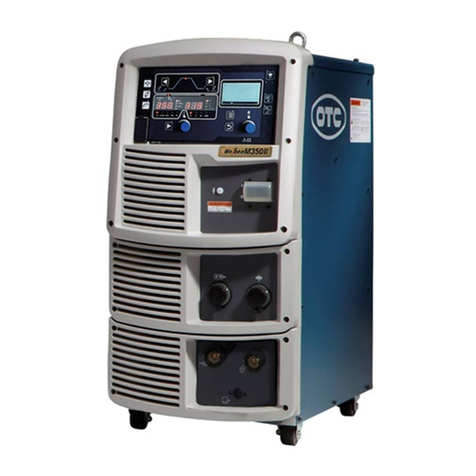
OTC
OTC Welbee M350 II User manual

OTC
OTC Welbee M350L II User manual
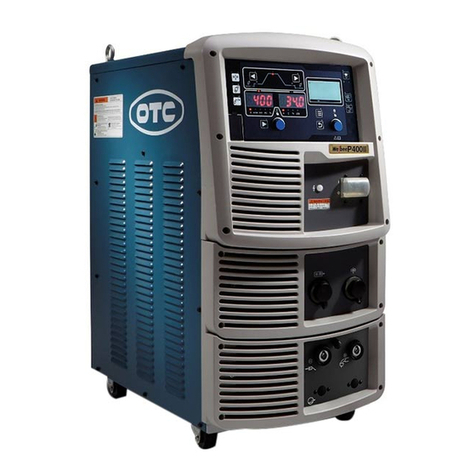
OTC
OTC Welbee P400 II User manual
